Arizona Sonora Desert Museum
by Jane St. Clair
The Arizona Sonora Desert Museum is three places in one. It’s hiking trails with gorgeous, panoramic views of the desert. It’s also a botanical garden, and a zoo. This makes it the Number One attraction in Tucson.

The first time I went to the Arizona Sonora Desert Museum I didn’t pay attention to the various spiders, insects and snakes. However, after I lived in Arizona a while, I became very interested in which one was which.
 If you don’t know one snake from another, you’ll mix up a nice king snake with a deadly coral. A plain brown house spider is harmless. A Brown Recluse Spider leaves a bite that turns into an ulcer that hurts for months. Little scorpions are more dangerous than big ones. Luckily, the Arizona Desert Museum has all these varieties so you can learn one from another.
If you don’t know one snake from another, you’ll mix up a nice king snake with a deadly coral. A plain brown house spider is harmless. A Brown Recluse Spider leaves a bite that turns into an ulcer that hurts for months. Little scorpions are more dangerous than big ones. Luckily, the Arizona Desert Museum has all these varieties so you can learn one from another.
Besides reptiles and insects, you also get to see all kinds of desert animals at this outdoor museum. Coyote, big horn sheep, elk deer and desert turtles all have nice habitats there. You’ll see animals you won’t see anywhere else, like ravens and javelina.
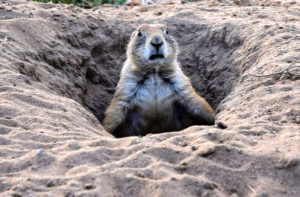 I like the prairie dog village with their funny little heads popping up and down out of their holes.
I like the prairie dog village with their funny little heads popping up and down out of their holes.
The museum has a great exhibit about animals that live underground to escape the terrible summer heat. You go into this dark tunnel and then you can peep at them in their burrows. Most of them, like kit foxes and kangaroo rats, sleep all day.
This being the American Southwest, there’s a big indoor exhibit on the geology of the mountains here – how they formed, how the desert itself formed after once being a gigantic sea, and what things looked like here millions of years ago.
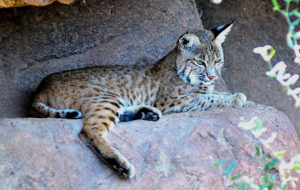
The indoor exhibits like the geology and reptile house are really nice in summer because they are cool inside. There’s also an amazing hummingbird exhibit, as well as an aviary.
As you walk around the Arizona-Sonora Desert Museum, you will love to take in the beautiful, panoramic overlooks of the desert. These alone are worth the price of admission.

My favorite part of the museum is a trail that shows you how the land,
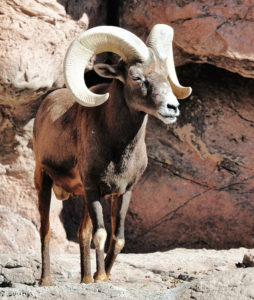 plants and animals change as you climb up a local mountain. At the bottom is the desert, but as you make your way up, you come across ponderosa, pine forest, and many other ecosystems. This is what makes the Tucson area one of the most biologically diverse in the planet.
plants and animals change as you climb up a local mountain. At the bottom is the desert, but as you make your way up, you come across ponderosa, pine forest, and many other ecosystems. This is what makes the Tucson area one of the most biologically diverse in the planet.
Plan on spending an entire day at the Arizona-Sonora Desert Museum. Besides the natural beauty of the place, you’ll love their fancy restaurants and awesome gift store.
Arizona Sonora Desert Museum has a terrific website not only with information on hours and tickets, but just about the desert in general.
Go here.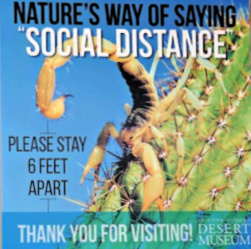
Tags: Arizona
Tarantulas by Jane St. Clair
When you live in the Arizona desert, you’re sure to see tarantulas. These are big hairy spiders that are quite scary when you come upon them.
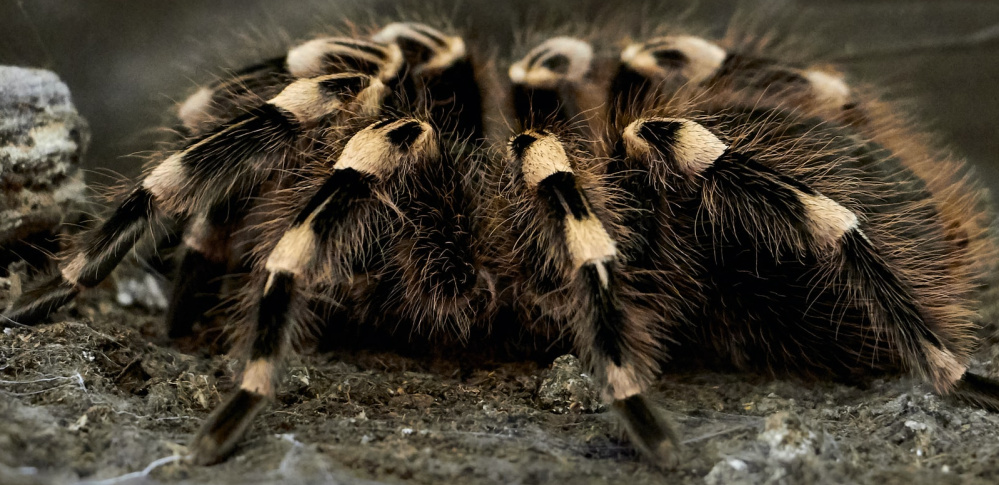
I once accidentally brought one in the house. He must have jumped into my laundry basket when I was bringing in clothes from outside.
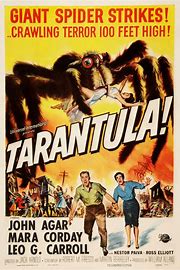 He crawled across the living room, looking like something out of a James Bond movie. His Dracula fangs were particularly scary.
He crawled across the living room, looking like something out of a James Bond movie. His Dracula fangs were particularly scary.
However, unlike spiders in horror movies, this tarantula didn’t chase anyone. Instead, he just ran away from us the way a mouse would. Even if he had bit someone, it would have ended up being more like a bee bite than a whack from a poisonous snake.
The thing is Hollywood makes people scared of tarantulas. Besides “Dr. No,” there’s a horror movie about hordes of tarantulas attacking a California town, and another one called “Tarantula!,” about a spider the size of the Chrysler Building. My favorite is “The Incredible Shrinking Man,” about a tiny person who uses a toothpick/sword to battle a huge spider.
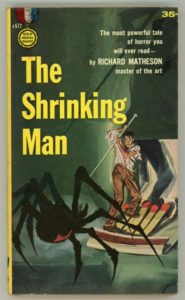
Even though tarantulas are big hairy spiders, they’re actually very sweet, docile animals For all we know, they may even be kindhearted.
Tarantulas are hunters even though they move slowly. They catch their food by sneaking up on prey and poisoning it. I guess their webs are just decorative.
If they get hurt while hunting, tarantulas can grow new legs if they have to.

Besides biting people, a tarantula will protect himself by throwing hairs at you from his belly. This experience can be painful. Also it leaves the spider with a bald spot on his tummy. By the way, tarantulas have very bad eyes, and use their hairs as sense organs
In a terrible example of sexual inequality, female tarantulas live 30 years but males only seven.
I hadn’t been in Arizona very long when I heard about Tarantula Hawks. I assumed they were big birds that went after big spiders, but no, that is wrong. Tarantula Hawks are quite disgusting insects who lay their eggs in the bellies of tarantula spiders.
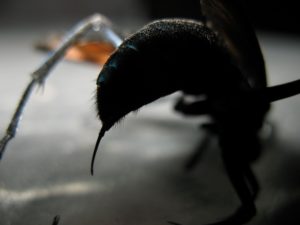
When the baby tarantula hawks hatch, they feed on the poor spider. There, I’ve just ruined your day for you.
Some people are crazy about tarantulas and keep them as pets. There is actually an American Tarantula Society dedicated to these spiders, as well there should be. However, this makes you wonder if they’ve seen any movies.

Tags: Tarantulas
Old Tucson Closed
by Jane St. Clair
Old Tucson closed because of Covid, and, as the French say, quelle tragique!
Movie companies made over 400 movies and TV shows at Old Tucson’s studio since it opened in 1939. This means that so much of the power and myth of the Old West came out of this historical place.
 Some TV classics like Gunsmoke, Bonanza, Have Gun Will Travel, and Little House on the Prairie shaped the way Americans picture the frontier, and the cowboys and cowgirls who built it. Likewise, classic movies like Tombstone and How the West Was Won, also filmed there.
Some TV classics like Gunsmoke, Bonanza, Have Gun Will Travel, and Little House on the Prairie shaped the way Americans picture the frontier, and the cowboys and cowgirls who built it. Likewise, classic movies like Tombstone and How the West Was Won, also filmed there.
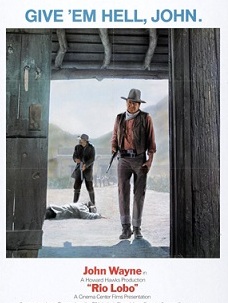
However, even non-western films came out of Old Tucson, like Tin Cup, Revenge of the Nerds, and Death Wish.
Before Old Tucson closed, it was not only a place to film movies, it was a tourist attraction. For a long time it was second only to the Grand Canyon as the most visited attractions in Arizona.
You could wander around the saloons and little shops, eat at Western-themed restaurants, and ride the train around the park. Every time the train went around the park, however, robbers would attack it every time.
Or you could also ride a stagecoach (bumpy).

You’d learn a lot about making western movies. Stunt cowboys would demonstrate how they’d make a fist fight look real or how they could safely fall from a building. You could wander inside the Old Tucson main studio, and see costumes, guns, and other props from great western films.
But I wouldn’t call it an educational spot. It was too much fun for that, especially at Halloween.
On April 24, 1995, Old Tucson had a massive fire that took out the main studio and three-fourths of its buildings. Some were just flimsy one-dimensional backdrops.
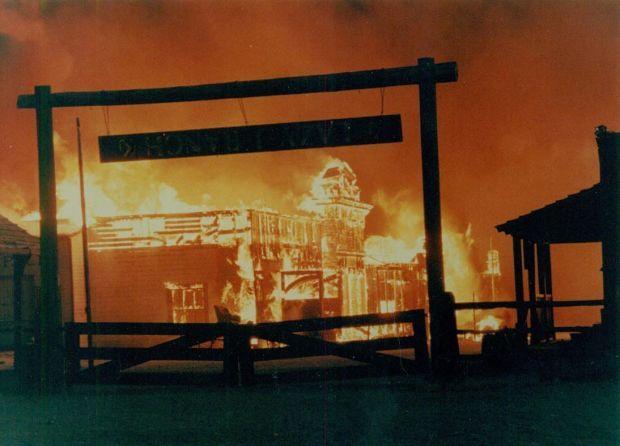
Yet it was a true disaster for film historians, because the fire destroyed costumes, piles of photos, rare behind-the-scenes footage, and even a priceless doll collection. Parts of the Reno, the park’s locomotive, melted. Old Tucson closed, and did not reopen until January 1997.
On September 14, 2020, because of Covid, Pima County took over Old Tucson. Pima County is working on a plan for the park’s future.
The park’s future cannot come too soon.

 For a description of Old Tucson before Covid, go here. For a list of movies filmed at Old Tucson, and a list of movies that used her locomotive, go here here.
For a description of Old Tucson before Covid, go here. For a list of movies filmed at Old Tucson, and a list of movies that used her locomotive, go here here.
Tags: Old Tucson
Big Horn Sheep
by Jane St. Clair
I love big horn sheep. I believe every fantastic thing that anyone tells me about them because they’re that amazing.
Once a guide on a tour at Sabino Canyon told our group that big horn sheep have suckers on the bottoms of their feet, which is why they can climb straight up rocks. I believed him.
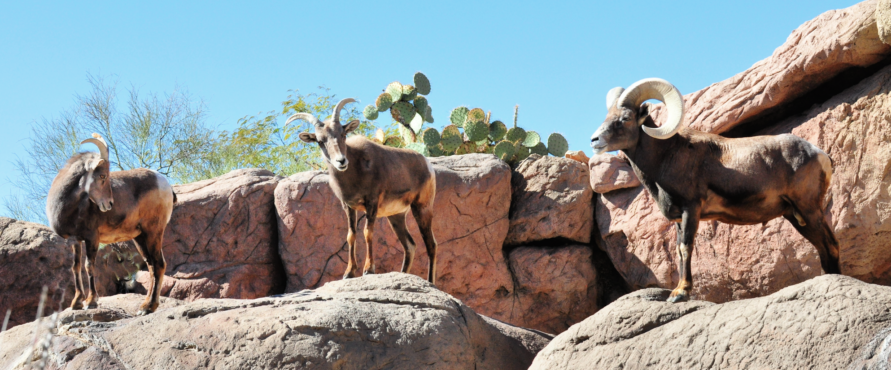
Because it looks like they have suckers on the bottom of their feet –or at least some kind of moon-walker thing—when you watch big horn sheep climb up the side of a mountain.
They look cool when they’re up so high. Big horn sheep definitely aren’t afraid of heights.
And then there’s those horns. Those horns are to die for. The horns can weigh 40 pounds on an animal that weighs about 300. How amazing is that? And look at the way the horns twist around the ram’s face, like beautiful coils on Princess Lelia. Gorgeous!
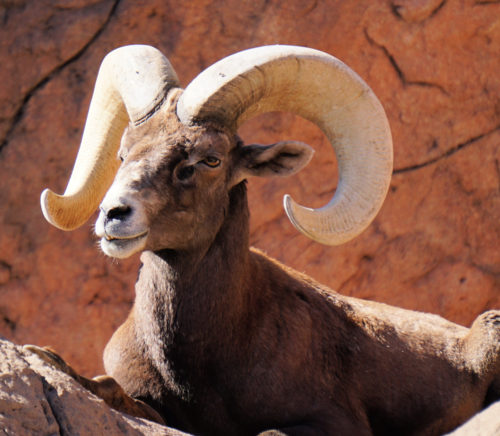
Here in Tucson, Arizona, government officials in charge of wildlife tried to reintroduce big horn sheep into Catalina State Park. Hundreds of them once roamed the mountains here,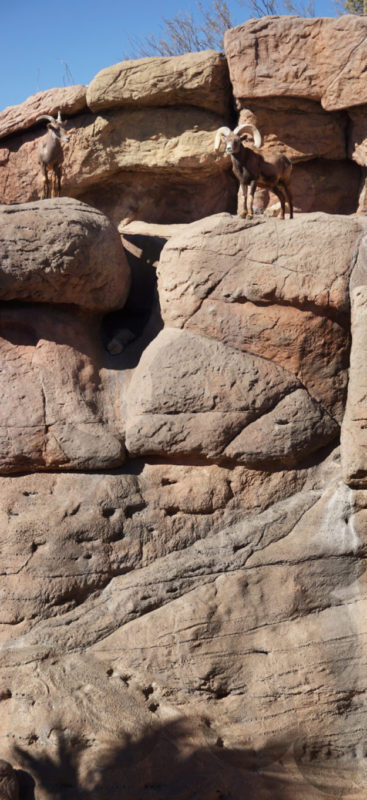
but now their numbers have dropped. It’s not bad enough to put them on the endangered species lists, but enough that you never see them where people used to see them a lot.
About seven years ago, the Wildlife Service started dropping big horn sheep into Catalina Park. The animals had computer chips in them so the rangers could trace their every movement. Sadly, as biologists monitored their screens for signs of movement and life, they realized that most of the new big horn sheep were dying. It is true some died naturally through accidents and such, because they were not used to their new home.
Yet the main reason sheep were flat-lining was that they had become mountain lion food.
Something had to be done about hungry mountain lions.
Almost immediately, people around here divided into Team Lion and Team Big Horn Sheep. Team Sheep wanted everything possible done to save the sheep. Team Lion argued lions were just doing what lions got to do, so it’s not fair to shoot them to protect another species.
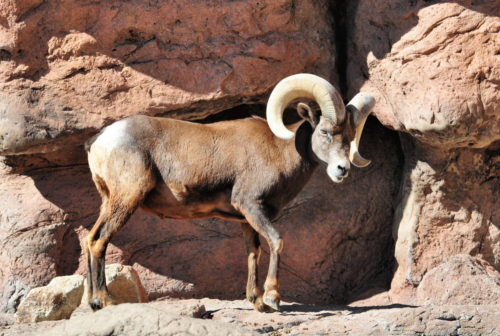
In the end, they reached a compromise. The Wildlife Service took new precautions with the second round of sheep they introduced into the park in the hope of making easier for them to survive, but they did shoot a few lions.
In 2018, about 65 sheep were living in Catalina State Park, and maybe 5,000 in the state of Arizona. So, with a little luck, the numbers will grow even bigger.
How lucky can we get?
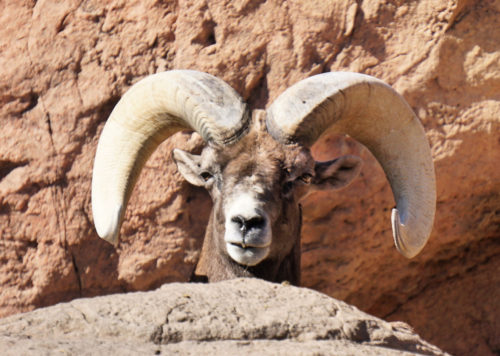
Here’s looking at you, babe.
* * * * * * * * *

Read Jane’s short story, “The Year of the Tomato” in The Bangalore Review.
Tags: Tucson
Tumamoc Hill
by Jane St. Clair
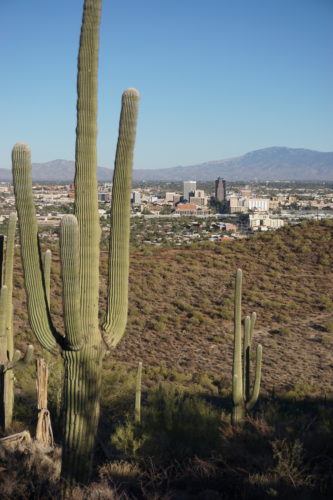 Tumamoc Hill is a three-mile round-trip to the top and back. It’s where people go in Tucson for a nice easy hike, often with friends and family. It’s got a nice easy wide road, so there’s nothing hard to navigate like hikes with steep rocky cliffs with zillion-mile drop-offs or wide streaming creeks with quicksand. No sir, Tumamoc Hill’s nice and easy.
Tumamoc Hill is a three-mile round-trip to the top and back. It’s where people go in Tucson for a nice easy hike, often with friends and family. It’s got a nice easy wide road, so there’s nothing hard to navigate like hikes with steep rocky cliffs with zillion-mile drop-offs or wide streaming creeks with quicksand. No sir, Tumamoc Hill’s nice and easy.
As a consequence, you see people of all ages and abilities there. The Hill gets over 1,000 hikers a day.
The best thing about Tumamoc Hill are the incredible views of the city. Once you’re at the top, you can see every little thing in Tucson. When you are up that high, it’s easy to pick out landmarks like certain downtown buildings and even radio towers on certain mountains in the distance.

People first lived on Tumamoc Hill fifteen hundred years ago, and they left us hundreds of interesting petroglyphs. When Europeans came to this spot, they used it as a look- out for Apache. The University of Arizona put their desert laboratory here in 1903, which has been operating ever since. Botanists and biologists study plants, reptiles and mammals of the desert on Tumamoc Hill, and their work has been ongoing for decades.
Highways look like swirly spaghetti from up here.

You usually just park your car along the side of the street and then start your trek up the hill from the bottom, where people are selling souvenirs and trinkets. If you want to go intellectual, you can download an app from the University of Arizona. Their lectures divide the hike into six parts with ten-minute talks for each section.
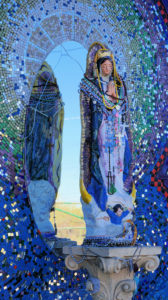 As you start to climb, one of the first things you’ll see is a altar to Our Luminous Mother made by a woman dying of cancer. Designed with a lot of blues and mirrors, the sanctuary is usually covered with milagros.
As you start to climb, one of the first things you’ll see is a altar to Our Luminous Mother made by a woman dying of cancer. Designed with a lot of blues and mirrors, the sanctuary is usually covered with milagros.
You walk up a wide paved path, easy-peasy hiking. Many people walk backwards so they don’t miss the views of the city and desert landscape. Some of these views are as breathtaking as the ones you’ll see at prime hiking spots in Tucson like the Saguaro National Monument and Sabino Canyon. About halfway up, you come to the U of A desert laboratory building made of stone.
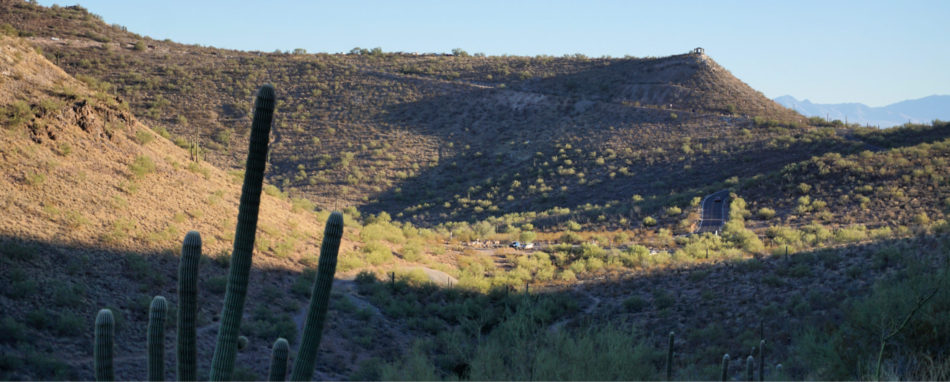
Tumamoc Hill almost spirals to the top. If you begin to falter before you make it to the summit, keep going. The views up there are worth it, plus you get to see all the buildings where the scientists work.
 For some reason unknown to humankind, Tumamoc means deadly lizard, however, they named it that anyway.
For some reason unknown to humankind, Tumamoc means deadly lizard, however, they named it that anyway.
To find out all kinds of information about Tumamoc Hill, including how to download the University of Arizona app, go here.
Tags: Tumamoc Hill
Percival Lowell Observatory
by Jane St. Clair
 Percival Lowell had this pigheaded belief that intelligent creatures lived on Mars. Without his vision, we’d have lost a lot of great science fiction. What’s more, we wouldn’t have found Pluto.
Percival Lowell had this pigheaded belief that intelligent creatures lived on Mars. Without his vision, we’d have lost a lot of great science fiction. What’s more, we wouldn’t have found Pluto.
Percival Lowell was born into such a distinguished family that eventually they had a town named after them in Massachusetts. His sister invented prenatal care, his brother became President of Harvard, and another sister became a famous poet. Not too much pressure there.

As an undergraduate at Harvard University, Percival was obsessed with astronomy. Everyone loved his graduation speech about the formation of the solar system. Nevertheless, Percival, being the good son that he was, gave up star-gazing and went to work at the family’s cotton mill.
After six long years he was unable to find fulfillment at the cotton mill. So, Percival took a few years off and traveled around the Far East.
 When Lowell was 38 years old, he read a book about Mars that changed his life. The author of this book, Giovanni Schiaparelli, was an Italian astronomer who had been observing Mars for years. He believed that all kinds of canals covered the surface of Mars. His ideas caught the imagination of Percival Lowell, who decided to devote the rest of his life to his first love — astronomy.
When Lowell was 38 years old, he read a book about Mars that changed his life. The author of this book, Giovanni Schiaparelli, was an Italian astronomer who had been observing Mars for years. He believed that all kinds of canals covered the surface of Mars. His ideas caught the imagination of Percival Lowell, who decided to devote the rest of his life to his first love — astronomy.
Lowell came out to Flagstaff, Arizona, in 1894 when it was still the Wild West. He set up his observatory on top of “Mars Hill,” picking that spot because it was almost 7,000 feet above sea level. At this time Flagstaff was a small town with very little light pollution. 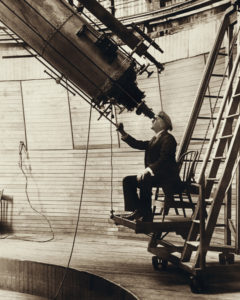 As things turned out, one of Lowell’s greatest contributions to astronomy was his common sense idea that it’s a good idea to set up your telescope high up on a hill far away from big city lights.
As things turned out, one of Lowell’s greatest contributions to astronomy was his common sense idea that it’s a good idea to set up your telescope high up on a hill far away from big city lights.
Percival Lowell believed Martians had an advanced civilization, but were in some kind of climate crisis. They were digging canals in order to tap their last source of water on their dying, drying planet, the water in its ice caps.
When Lowell published his ideas, Schiaparelli grew very annoyed with him. Something major had been lost in translation. “Canalis” in Italian means channels, as in natural waterways like the English Channel. Schiaparelli didn’t mean “canals” like the ones in Venice. Yet Lowell refused to correct himself.
However, his ideas did not annoy the public, in fact, 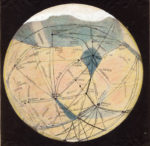 people loved the notion of Little Green Men just one planet from earth. Lowell’s maps of Mars made astronomy so popular that Lowell became the Carl Sagan of his times. His books and maps inspired all kinds of science fiction books and comics about intelligent life on Mars.
people loved the notion of Little Green Men just one planet from earth. Lowell’s maps of Mars made astronomy so popular that Lowell became the Carl Sagan of his times. His books and maps inspired all kinds of science fiction books and comics about intelligent life on Mars.
Besides firing up the public about Mars, Percival Lowell’s other big contribution was the discovery of Pluto. He believed (wrongly) that the orbits of Neptune and Uranus were wobbling because another planet must be out there affecting them. He named it Planet X. Lowell also observed “spokes” on Venus.
 However, he was only a little bit right. Neptune and Uranus weren’t wobbling. Venus did not have spokes. Lowell was seeing spokes because he was probably looking at the blood vessels in his own eyes, having screwed up the lens in his telescope. Nevertheless, fourteen years after Percival Lowell died, astronomers at Lowell Observatory did find Planet X, which they named Pluto. Pluto has since been downgraded to a dwarf planet.
However, he was only a little bit right. Neptune and Uranus weren’t wobbling. Venus did not have spokes. Lowell was seeing spokes because he was probably looking at the blood vessels in his own eyes, having screwed up the lens in his telescope. Nevertheless, fourteen years after Percival Lowell died, astronomers at Lowell Observatory did find Planet X, which they named Pluto. Pluto has since been downgraded to a dwarf planet.
I like to think that Percival Lowell was a friend of Daniel Barringer. Barringer lived just 30 miles east of Flagstaff, and was spending his whole life digging for iron in a meteor crater. Just as Lowell was wrong about Little Green Men and Planet X, Barringer was wrong about the Giant Meteor Crater. What a wild place northern Arizona must have been in 1900!
Today you can visit both the Giant Meteor Crater and Lowell Observatory.. Just the view of Flagstaff from Mars Hill is worth the trek up there.
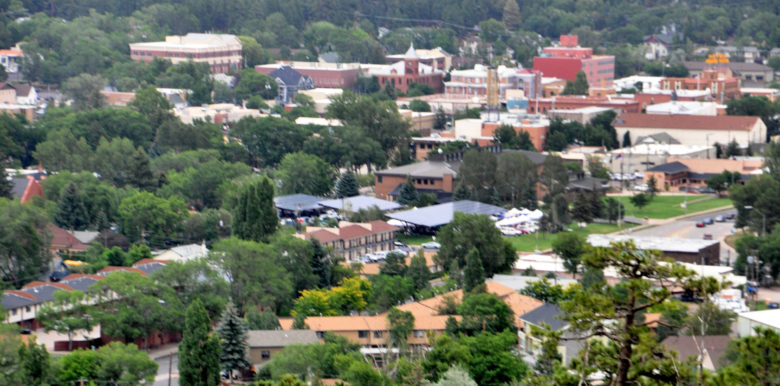
You can sense the spirit of Percival Lowell and his intense curiosity about the entire cosmos as you visit his observatory and telescopes.
I think he’d have liked that Time Magazine once designated Lowell Observatory as one of the 100 Most Important Places in the World.
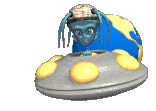
A little update (as if timeless topics like astronomy have updates):
On March 29, 2024, the Governor of Arizona declared Pluto to be Arizona’s official planet, even though Pluto has been downgraded to not-a-planet. Or if it is a planet, it’s been downgraded to only-a-dwarf.
Tags: Arizona
Bighorn Fire
by Jane St. Clair
On Sunday, June 6, in the morning, I went out to greet Pusch Ridge. It’s a daily ritual to me, along with wishing good night to the constellation Orion.
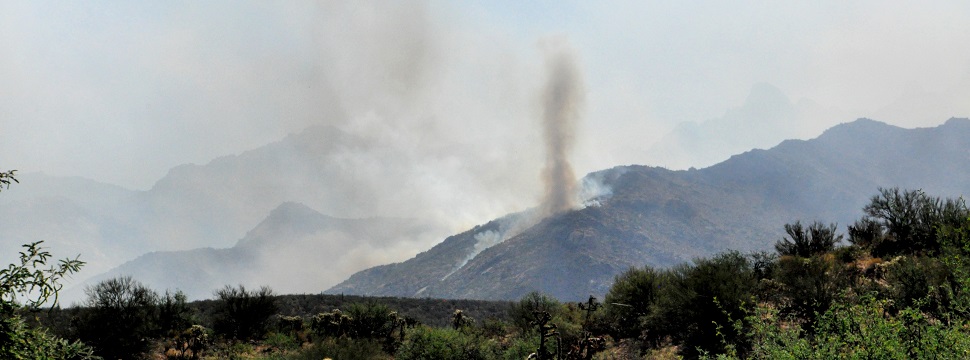
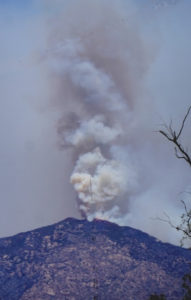
It surprised me to see that Pusch Ridge was on fire. I felt sad, like you do when you see a friend in trouble.
Yet the Bighorn Fire, as the fire fighters named it, was darn interesting. Interesting in the way natural processes are, like a spider spinning a web or a butterfly coming out of a cocoon. I couldn’t stop watching it. I wondered if other people stood where I was standing now and watched a fire on this very same mountain five thousands years ago.
Probably.

The Bighorn Fire keeps spreading. People in Tucson keep track of it, like you keep track of numbers in the corona virus. 13,000 acres burned, 5% contained. 27,000 acres burned, 15% contained. Today the fire still marches forward in its relentless way. After more than three weeks, the numbers say we’re at 115,000 acres burned, and 45% contained.
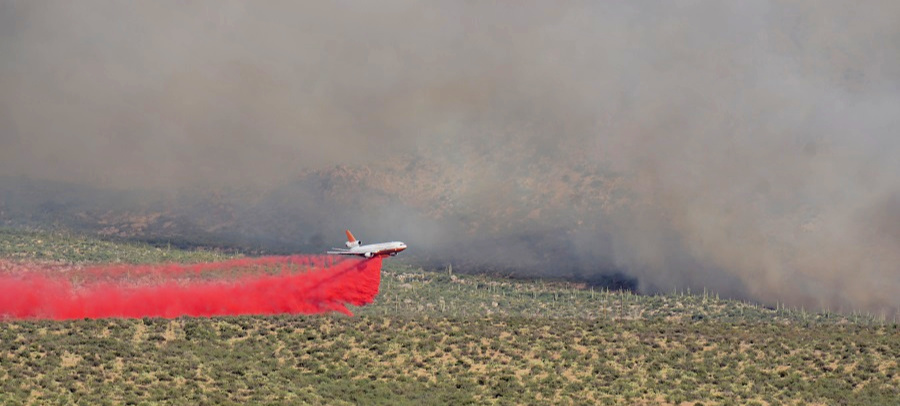
Fire fighters tell us it’s dangerous out there because the Bighorn Fire hides inside deep canyons. Big planes survey and then come back to drop red retardant over it. This makes red patterns all over the mountain range. They look like the artist Cristo made them.
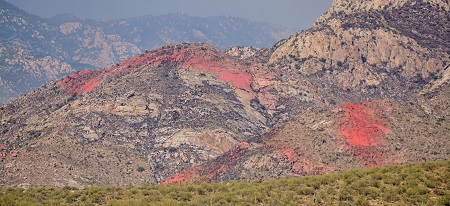
The Big Horn Fire is not eating up houses and garages and such. When it got near the town on top of Mount Lemmon last week, fire fighters diverted it away from property. At this time firefighters have had to evacuate only a few communities. The fire has killed over 3000 saguaros and many other trees and plants. It is blackening whole sides of the mountains.
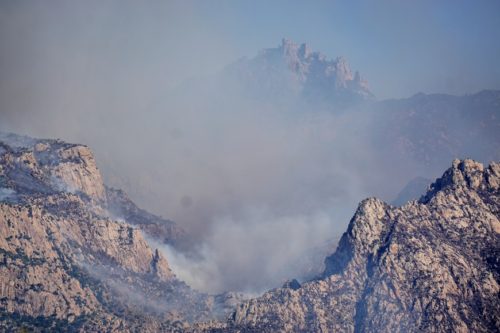 Sometimes you can see flames, especially at night. The fire fills the mountains’ canyons and crevices with smoke like giant witches’ cauldrons. Sometimes smoke goes straight up in the air. Other times it goes up in little puffs on top of one another, like a series of ruffles.
Sometimes you can see flames, especially at night. The fire fills the mountains’ canyons and crevices with smoke like giant witches’ cauldrons. Sometimes smoke goes straight up in the air. Other times it goes up in little puffs on top of one another, like a series of ruffles.
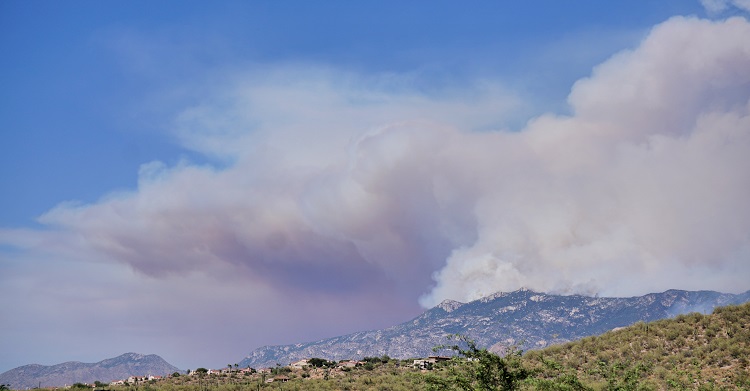
But sometimes it’s just one big blue fog. The air smells like a burnt-out fireplace, while all the smoke makes it hard to breathe, especially with a mask on.
I am watching Pusch Ridge, knowing it’s not over. A bolt of lightning caused the Big Horn fire, not careless campers or smokers or anything like that. The fire is part of nature.
We are praying for rain, like the people who lived here so many thousands of years ago. Somehow I have the feeling that everything will be all right. And this mountain, like so many other things right now, will one day go back to being himself.

To see how Pusch Ridge is on a normal day, go to Crouching Tiger, Hidden Dragon.
Tags: Tucson
Tucson Barrio
by Jane St. Clair
“I am always drawn back to the places where I have lived, the houses and their neighborhoods,” Truman Capote once wrote.

But when you do go back to those places, they look different — even though your overall memories of your city can be accurate. For example, sometimes I think of Manhattan, where I once lived. I remember the Art Deco style, its skylines, and its crowded streets. If it were music, it would be Gershwin.
I remember Chicago, as Carl Sandburg wrote, with big shoulders and a tougher edge to it, with its tall beauty standing against the shores of Lake Michigan.

San Francisco is strangely western and eastern to me all at once, with its Victorian pink ladies standing in front of the modern age, almost as if Victoria is refusing to budge.
A city’s past, its geography and climate, its architecture and its setting are what you remember about it.

Tucson is about desert, an extreme climate, adobe brick, and its long long history.
Although you think of the American West as new, Tucson is one of the oldest cities in the United States.
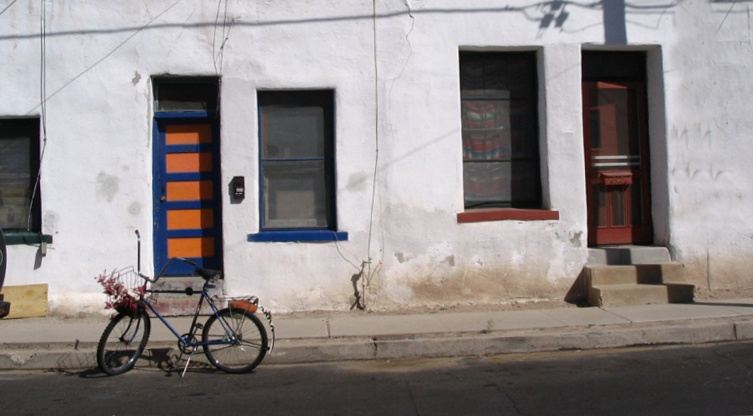
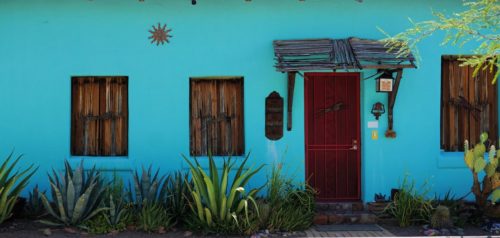
In the 1770s Alexander Hamilton and Aaron Burr were doing their thing back East. Yet people here had already built the presidio to protect them against the Apache. Tucson was then part of Mexico, and stayed that way until 1854. Meanwhile for the next 100 years, the Tucson Barrio with its unique abode houses kept growing into a large neighborhood south of the city’s center.
In the 1950s, in the name of progress, the city fathers of Tucson tried to bulldoze the Tucson Barrio to make way for skyscrapers. There was a fight that ended with leaving part of the Tucson Barrio still standing, including the Shrine of El Triadito, now a historic landmark.
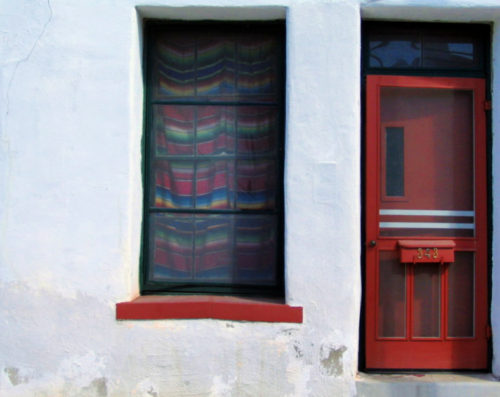
Today the Tucson Barrio is a really interesting and vibrant neighborhood, probably one of the most diverse American neighborhoods in terms of income. All kinds of people, wealthy and not so wealthy, have moved into the area and are restoring the buildings, painting them vibrant colors while keeping their architectural integrity. I love their boxy lines, and the way their bright colors contrast with the West’s big turquoise sky.
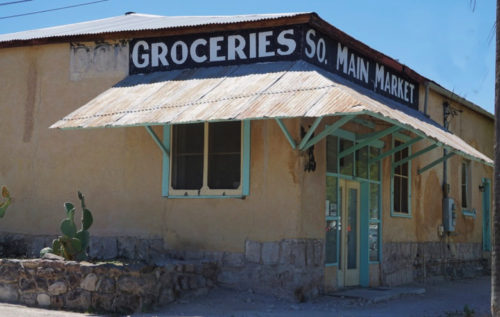
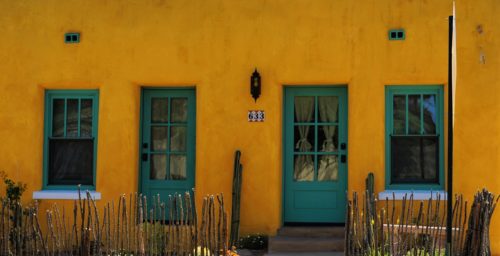
Someday, when I am drawn back to the places where I have lived, I’ll remember Tucson in terms of these bright and wonderful adobe houses standing in front of slick city buildings. It’s a unique and wonderful image, and it defines Tucson.



 …………………..
…………………..
 ………………..
………………..
At left is a picture of a Corona Virus pinata. I think we’d all love to give it a good whack.
For more pictures of the Tucson Barrio, go to 1 -2 -3 Southwest Doors.
………………..
Tags: Tucson
Tucson Museum of Miniatures
by Jane St. Clair
When I was a little girl in Chicago, my dream was to grow up and be the tour guide at Colleen Moore’s Dollhouse. I just knew I wanted to spend all day by that dollhouse.
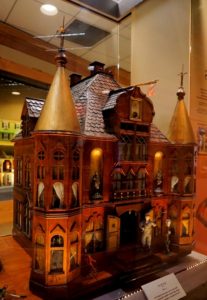 But the Museum of Science and Industry did away with tour guides and replaced them with recorded messages.
But the Museum of Science and Industry did away with tour guides and replaced them with recorded messages.
Although technology dashed my dreams, I grew up anyway, as most people manage to do. Luckily, we moved to Arizona, home of the Tucson Museum of Miniatures.
And what an enchanted place it is! They have not one, but 500 DOLLHOUSES! 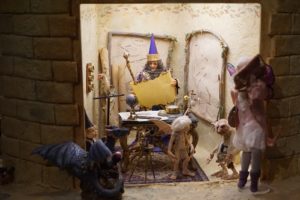 Each one is its own little fairy tale.
Each one is its own little fairy tale.
You get not only castles for your princes and princesses, you get little houses for elves. Gnome rooms. Bridal salons for brides the size of Thumbelina.
There’s a magical tree with windows where you can peek and see how fairies live. A forest of Kewpie dolls.
A Christmas village that goes on and on under silver trees.
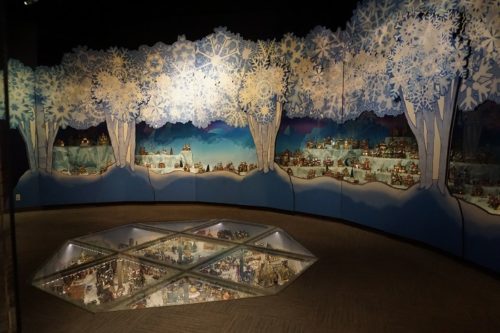
Then there’s the floor made like a window that surprises you with miniatures under your feet. Miniatures everywhere is the motto here!

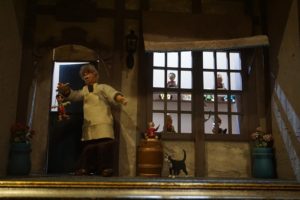 I like how you can find celebrities hanging out here like Scarlett and her Rhett, Geppetto and Pinocchio.
I like how you can find celebrities hanging out here like Scarlett and her Rhett, Geppetto and Pinocchio.
But what I like best is how you get to remember being six years old when dollhouses fit you better than the bigness of the adult-controlled world.
The Tucson Museum of Miniatures has the official name of Tucson Mini-Time Machine Museum of Miniatures. 
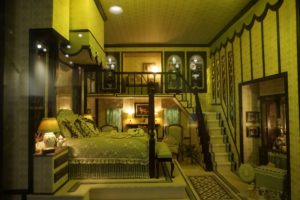
That’s a nice name for it, because so many of the little dioramas and dollhouses are tiny representations of other eras. A 1920s Great Gatsby house preparing for a wedding. A 1940s tenement building with a sailor saying good-bye to his sweetheart. A white Christmas interior from the 1900s. And an Old Dutch kitchen from the 1600s.
The museum also has enchanted tiny places full of gnomes and wizards, pink toy stores, and fantasy castles.
The makers of these little enchanted places have given us a fairy tale, so we thank them for that. We thank them for filling our eyes with wonder again.
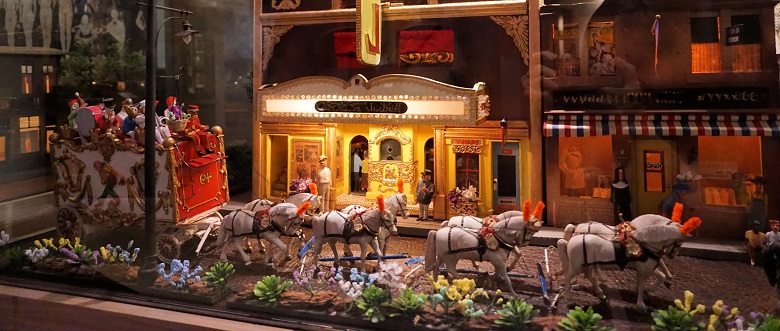
It reminds me of this poem by Lewis Carroll:
Child of the pure unclouded brow
And dreaming eyes of wonder!
Though time be fleet, and I and thou
Are half a life asunder,
Thy loving smile will surely hail
The love-gift of a fairy-tale.
 To plan your trip to this museum, click here. A lot of people don’t know that you can find fairies in the Arizona desert. To learn how to do that, click here.
To plan your trip to this museum, click here. A lot of people don’t know that you can find fairies in the Arizona desert. To learn how to do that, click here.
Tags: Arizona · Jane St. Clair · Tucson · Uncategorized
Canoa Ranch
By Jane St. Clair
The thing about Canoa Ranch is how big it is. It once spread out over 330,000 acres along the Santa Cruz River about 35 miles from Tucson. At its peak, it was home to over 80,000 head of cattle.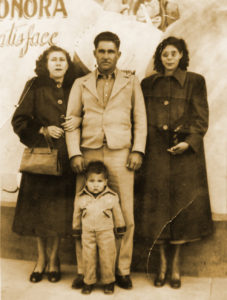 Besides being unusually big, Canoa Ranch was unusually sophisticated. Many of its cattle were purebreds –some even imported from Scotland. Its wealthy owner hired architects to design his ranch house and other matching buildings. It’s not every ranch house that gets a write-up in a fancy architectural journal.
Besides being unusually big, Canoa Ranch was unusually sophisticated. Many of its cattle were purebreds –some even imported from Scotland. Its wealthy owner hired architects to design his ranch house and other matching buildings. It’s not every ranch house that gets a write-up in a fancy architectural journal.
Canoa Ranch peaked when the cattle industry did, between 1940 and 1960. Back then about 80 families lived out there. One of them was the Giljava family, with little Raul shown here with his parents. Raul Griljava grew up to be a U.S. Congressman who has represented his district of south Tucson for over 14 years.
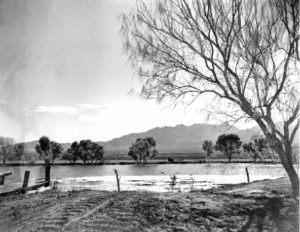
 For decades the Manning family owned Canoa Ranch. The story goes that Levi Manning and one of his fraternity brothers from the University of Mississippi let loose an elephant from a traveling circus. As the elephant terrorized their town, Manning’s mother told him he’d better “Go West, young man” before the police caught up with him. He came to Tucson and became a millionaire as well the town’s mayor. There he built the mansion now known as “Tucson’s Downton Abbey.”
For decades the Manning family owned Canoa Ranch. The story goes that Levi Manning and one of his fraternity brothers from the University of Mississippi let loose an elephant from a traveling circus. As the elephant terrorized their town, Manning’s mother told him he’d better “Go West, young man” before the police caught up with him. He came to Tucson and became a millionaire as well the town’s mayor. There he built the mansion now known as “Tucson’s Downton Abbey.”
Manning also put Canoa Ranch together, which he eventually handed over to his son.
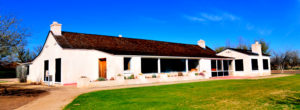
In the 1970s because Americans turned to white meat and vegetarianism, the cattle industry began to decline. Canoa Ranch declined along with it. For years its buildings lay in ruins until the Pima County Park District bought about 5,000 acres to preserve as an historic site. Parks and Recs restored not only buildings and fences, they also filled in the dried-up lake.
Canoa Ranch tells not only the Manning’s story but also those of the Mexican families and cowboys who lived out here. These were the people who did the dangerous work of ranching in what can be a hot cruel county. The Pima Park District is preserving their homes and lifestyles as well as the wealthy owner’s.
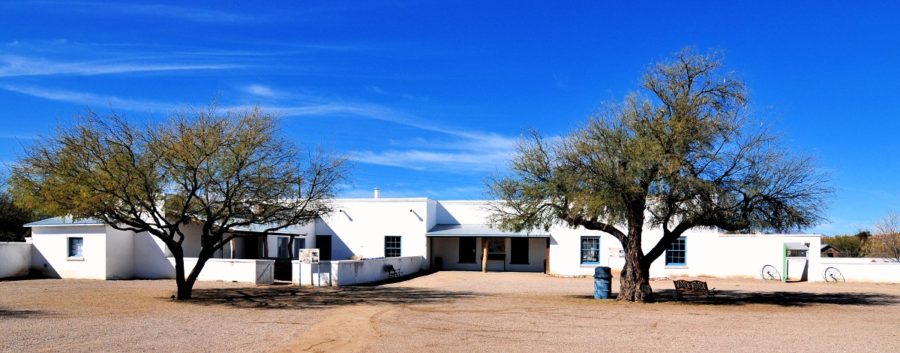
It’s easy to imagine the cowboys and the vaqueros working in this giant corral during round-up, blacksmithing in the huge tack room, building these thick fences from logs during winter, and settling down in the bunkhouse at night.
You can go into the huge tack room and see exhibits of branding irons, saddles and other ranch equipment. Also, you can tour the owner’s house where Manning, who like every other rancher in the world, hung a picture of his horse over his fireplace.
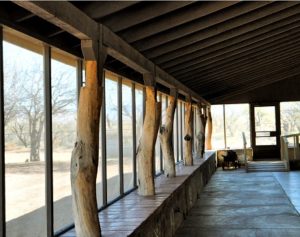 Since some buildings still have old furniture, clothing, dishes and even toys, you can get an idea of life out there without electricity, TV, radio, or even good libraries. I loved the porch made with tree stumps where the foreman and his family would sleep on hot summer nights.
Since some buildings still have old furniture, clothing, dishes and even toys, you can get an idea of life out there without electricity, TV, radio, or even good libraries. I loved the porch made with tree stumps where the foreman and his family would sleep on hot summer nights.
Today Canoa Ranch’s buildings are crisp and white against the bright blue Arizona sky. It almost feels like spending a day by the ocean, all blue colors with bright white sails cutting white angles and lines. Likewise it makes you remember times past and the reasons why we love the Old West.
To plan your visit to the historic Canoa Ranch, go here.
One of Jane St. Clair’s short stories is a finalist in the Tucson Festival of Books fiction contest.
Tags: Uncategorized

 If you don’t know one snake from another, you’ll mix up a nice king snake with a deadly coral. A plain brown house spider is harmless. A Brown Recluse Spider leaves a bite that turns into an ulcer that hurts for months. Little scorpions are more dangerous than big ones. Luckily, the Arizona Desert Museum has all these varieties so you can learn one from another.
If you don’t know one snake from another, you’ll mix up a nice king snake with a deadly coral. A plain brown house spider is harmless. A Brown Recluse Spider leaves a bite that turns into an ulcer that hurts for months. Little scorpions are more dangerous than big ones. Luckily, the Arizona Desert Museum has all these varieties so you can learn one from another. I like the prairie dog village with their funny little heads popping up and down out of their holes.
I like the prairie dog village with their funny little heads popping up and down out of their holes. 

 plants and animals change as you climb up a local mountain. At the bottom is the desert, but as you make your way up, you come across ponderosa, pine forest, and many other ecosystems. This is what makes the Tucson area one of the most biologically diverse in the planet.
plants and animals change as you climb up a local mountain. At the bottom is the desert, but as you make your way up, you come across ponderosa, pine forest, and many other ecosystems. This is what makes the Tucson area one of the most biologically diverse in the planet.



 He crawled across the living room, looking like something out of a James Bond movie. His Dracula fangs were particularly scary.
He crawled across the living room, looking like something out of a James Bond movie. His Dracula fangs were particularly scary. 



 Some TV classics like Gunsmoke, Bonanza, Have Gun Will Travel, and Little House on the Prairie shaped the way Americans picture the frontier, and the cowboys and cowgirls who built it. Likewise, classic movies like Tombstone and How the West Was Won, also filmed there.
Some TV classics like Gunsmoke, Bonanza, Have Gun Will Travel, and Little House on the Prairie shaped the way Americans picture the frontier, and the cowboys and cowgirls who built it. Likewise, classic movies like Tombstone and How the West Was Won, also filmed there.



 For a description of Old Tucson before Covid, go
For a description of Old Tucson before Covid, go 





 Tumamoc Hill is a three-mile round-trip to the top and back. It’s where people go in Tucson for a nice easy hike, often with friends and family. It’s got a nice easy wide road, so there’s nothing hard to navigate like hikes with steep rocky cliffs with zillion-mile drop-offs or wide streaming creeks with quicksand. No sir, Tumamoc Hill’s nice and easy.
Tumamoc Hill is a three-mile round-trip to the top and back. It’s where people go in Tucson for a nice easy hike, often with friends and family. It’s got a nice easy wide road, so there’s nothing hard to navigate like hikes with steep rocky cliffs with zillion-mile drop-offs or wide streaming creeks with quicksand. No sir, Tumamoc Hill’s nice and easy. 

 As you start to climb, one of the first things you’ll see is a altar to Our Luminous Mother made by a woman dying of cancer. Designed with a lot of blues and mirrors, the sanctuary is usually covered with milagros.
As you start to climb, one of the first things you’ll see is a altar to Our Luminous Mother made by a woman dying of cancer. Designed with a lot of blues and mirrors, the sanctuary is usually covered with milagros.
 For some reason unknown to humankind, Tumamoc means deadly lizard, however, they named it that anyway.
For some reason unknown to humankind, Tumamoc means deadly lizard, however, they named it that anyway. Percival Lowell had this pigheaded belief that intelligent creatures lived on Mars. Without his vision, we’d have lost a lot of great science fiction. What’s more, we wouldn’t have found Pluto.
Percival Lowell had this pigheaded belief that intelligent creatures lived on Mars. Without his vision, we’d have lost a lot of great science fiction. What’s more, we wouldn’t have found Pluto.
 When Lowell was 38 years old, he read a book about Mars that changed his life. The author of this book, Giovanni Schiaparelli, was an Italian astronomer who had been observing Mars for years. He believed that all kinds of canals covered the surface of Mars. His ideas caught the imagination of Percival Lowell, who decided to devote the rest of his life to his first love — astronomy.
When Lowell was 38 years old, he read a book about Mars that changed his life. The author of this book, Giovanni Schiaparelli, was an Italian astronomer who had been observing Mars for years. He believed that all kinds of canals covered the surface of Mars. His ideas caught the imagination of Percival Lowell, who decided to devote the rest of his life to his first love — astronomy. As things turned out, one of Lowell’s greatest contributions to astronomy was his common sense idea that it’s a good idea to set up your telescope high up on a hill far away from big city lights.
As things turned out, one of Lowell’s greatest contributions to astronomy was his common sense idea that it’s a good idea to set up your telescope high up on a hill far away from big city lights. people loved the notion of Little Green Men just one planet from earth. Lowell’s maps of Mars made astronomy so popular that Lowell became the Carl Sagan of his times. His books and maps inspired all kinds of science fiction books and comics about intelligent life on Mars.
people loved the notion of Little Green Men just one planet from earth. Lowell’s maps of Mars made astronomy so popular that Lowell became the Carl Sagan of his times. His books and maps inspired all kinds of science fiction books and comics about intelligent life on Mars. However, he was only a little bit right. Neptune and Uranus weren’t wobbling. Venus did not have spokes. Lowell was seeing spokes because he was probably looking at the blood vessels in his own eyes, having screwed up the lens in his telescope. Nevertheless, fourteen years after Percival Lowell died, astronomers at Lowell Observatory did find Planet X, which they named Pluto. Pluto has since been downgraded to a dwarf planet.
However, he was only a little bit right. Neptune and Uranus weren’t wobbling. Venus did not have spokes. Lowell was seeing spokes because he was probably looking at the blood vessels in his own eyes, having screwed up the lens in his telescope. Nevertheless, fourteen years after Percival Lowell died, astronomers at Lowell Observatory did find Planet X, which they named Pluto. Pluto has since been downgraded to a dwarf planet.






 Sometimes you can see flames, especially at night. The fire fills the mountains’ canyons and crevices with smoke like giant witches’ cauldrons. Sometimes smoke goes straight up in the air. Other times it goes up in little puffs on top of one another, like a series of ruffles.
Sometimes you can see flames, especially at night. The fire fills the mountains’ canyons and crevices with smoke like giant witches’ cauldrons. Sometimes smoke goes straight up in the air. Other times it goes up in little puffs on top of one another, like a series of ruffles.










 ………………..
……………….. But the Museum of Science and Industry did away with tour guides and replaced them with recorded messages.
But the Museum of Science and Industry did away with tour guides and replaced them with recorded messages.  Each one is its own little fairy tale.
Each one is its own little fairy tale. 

 I like how you can find celebrities hanging out here like Scarlett and her Rhett, Geppetto and Pinocchio.
I like how you can find celebrities hanging out here like Scarlett and her Rhett, Geppetto and Pinocchio.



 Besides being unusually big, Canoa Ranch was unusually sophisticated. Many of its cattle were purebreds –some even imported from Scotland. Its wealthy owner hired architects to design his ranch house and other matching buildings. It’s not every ranch house that gets a write-up in a fancy architectural journal.
Besides being unusually big, Canoa Ranch was unusually sophisticated. Many of its cattle were purebreds –some even imported from Scotland. Its wealthy owner hired architects to design his ranch house and other matching buildings. It’s not every ranch house that gets a write-up in a fancy architectural journal.
 For decades the Manning family owned Canoa Ranch. The story goes that Levi Manning and one of his fraternity brothers from the University of Mississippi let loose an elephant from a traveling circus. As the elephant terrorized their town, Manning’s mother told him he’d better “Go West, young man” before the police caught up with him. He came to Tucson and became a millionaire as well the town’s mayor. There he built the mansion now known as “Tucson’s Downton Abbey.”
For decades the Manning family owned Canoa Ranch. The story goes that Levi Manning and one of his fraternity brothers from the University of Mississippi let loose an elephant from a traveling circus. As the elephant terrorized their town, Manning’s mother told him he’d better “Go West, young man” before the police caught up with him. He came to Tucson and became a millionaire as well the town’s mayor. There he built the mansion now known as “Tucson’s Downton Abbey.”


 Since some buildings still have old furniture, clothing, dishes and even toys, you can get an idea of life out there without electricity, TV, radio, or even good libraries. I loved the porch made with tree stumps where the foreman and his family would sleep on hot summer nights.
Since some buildings still have old furniture, clothing, dishes and even toys, you can get an idea of life out there without electricity, TV, radio, or even good libraries. I loved the porch made with tree stumps where the foreman and his family would sleep on hot summer nights.